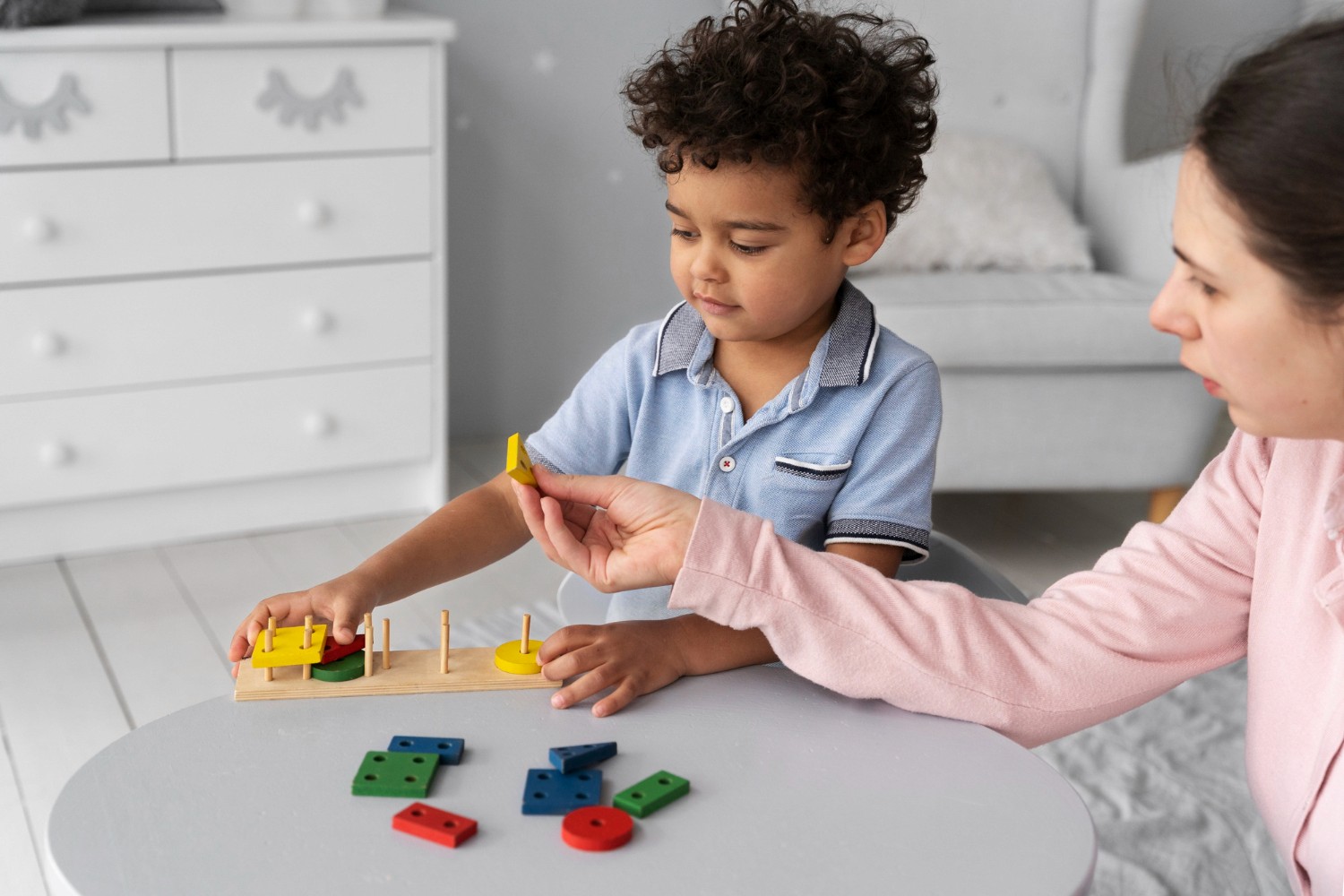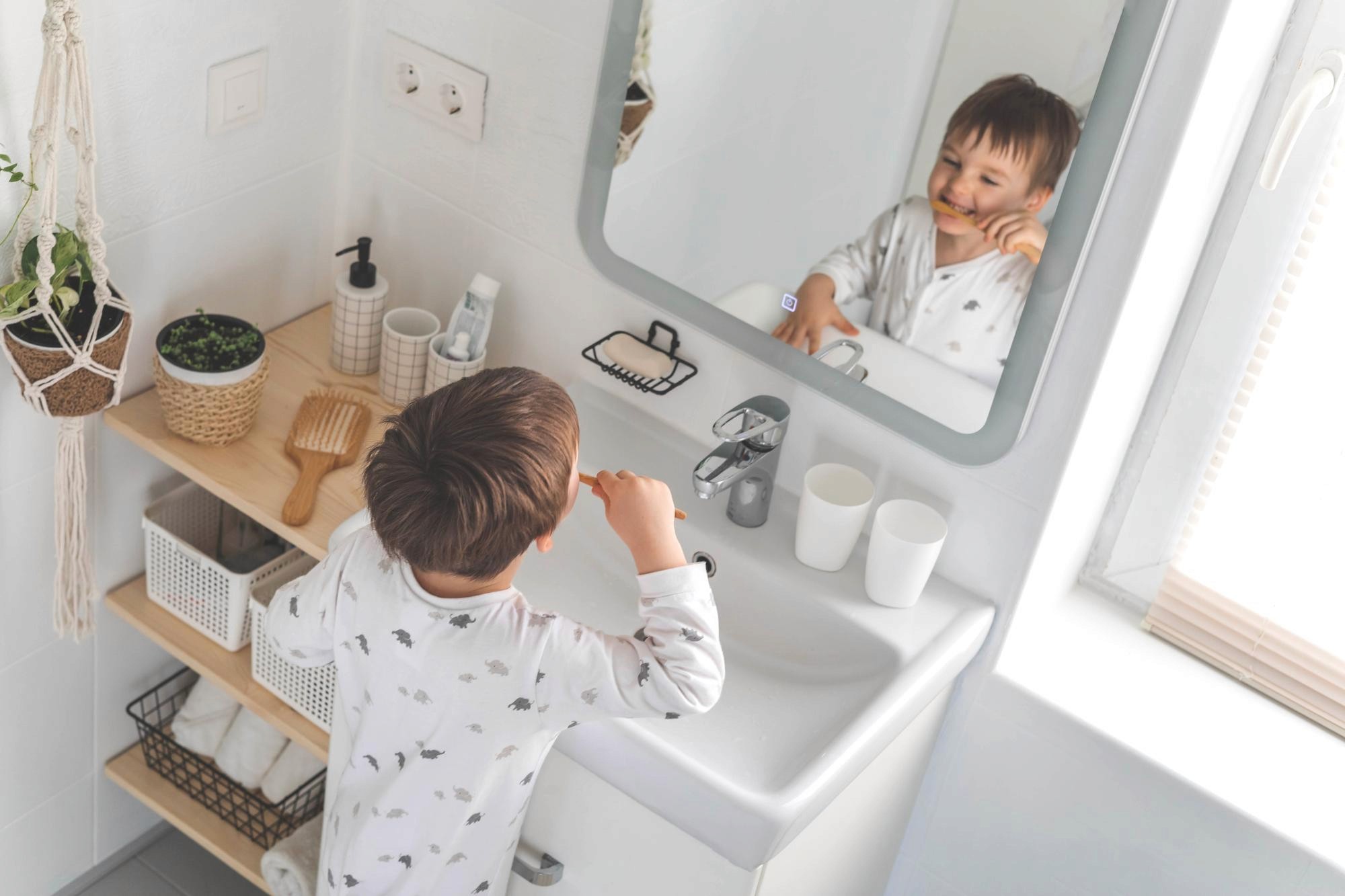Our New Clinic in Peachtree Corners is Now Open! Serving families in Norcross, Dunwoody, Sandy Springs, Duluth, Johns Creek, Alpharetta, Roswell, Suwanee, Brookhaven & nearby areas.

In-Home ABA Therapy for Kids with Autism
In-Home ABA Therapy for Kids with Autism
Blossom ABA Therapy delivers personalized ABA therapy straight to your home. Our expert team customizes sessions to fit your child's unique needs in a familiar, comfortable setting, promoting effective learning and significant progress. Let us help your child thrive.

In-Home ABA Therapy for Kids with Autism
Blossom ABA Therapy delivers personalized ABA therapy straight to your home. Our expert team customizes sessions to fit your child's unique needs in a familiar, comfortable setting, promoting effective learning and significant progress. Let us help your child thrive.

What Is In-Home ABA Therapy?
In-home ABA therapy provides personalized support for your child’s needs in the comfort of your home. Our Behavior Technicians apply behavioral principles to real-life situations, using positive reinforcement and teaching strategies to reduce challenging behaviors and promote positive ones. Integrating skills into daily routines and involving the family fosters meaningful, lasting progress in a supportive and familiar environment.






What Is In-Home ABA Therapy?
In-home ABA therapy provides personalized support for your child’s needs in the comfort of your home. Our Behavior Technicians apply behavioral principles to real-life situations, using positive reinforcement and teaching strategies to reduce challenging behaviors and promote positive ones. Integrating skills into daily routines and involving the family fosters meaningful, lasting progress in a supportive and familiar environment.


Benefits of Applied Behavior Analysis at Home
Benefits of Applied Behavior Analysis at Home




1. Familiar and comfortable space:
1. Familiar and comfortable space:
In-home ABA therapy occurs in a familiar environment, which can be less overwhelming for children who struggle with large, unfamiliar settings. This “safe space” can ease the transition into therapy and reduce distractions, allowing for more focused skill-building.
In-home ABA therapy occurs in a familiar environment, which can be less overwhelming for children who struggle with large, unfamiliar settings. This “safe space” can ease the transition into therapy and reduce distractions, allowing for more focused skill-building.
2. Insight into daily routines:
2. Insight into daily routines:
Therapists gain a deeper understanding of your family’s daily routines and dynamics by working within your home. This insight helps them create personalized goals and strategies directly relevant to your child’s everyday life.
Therapists gain a deeper understanding of your family’s daily routines and dynamics by working within your home. This insight helps them create personalized goals and strategies directly relevant to your child’s everyday life.








3. Real-life skill application:
3. Real-life skill application:
Therapy in the home allows for natural environment training, addressing skills like self-care, family mealtime, and bedtime routines in the actual settings where they occur. This approach enhances the child’s generalization skills and promotes quicker, more practical learning.
Therapy in the home allows for natural environment training, addressing skills like self-care, family mealtime, and bedtime routines in the actual settings where they occur. This approach enhances the child’s generalization skills and promotes quicker, more practical learning.
4. Addressing home-specific behaviors:
4. Addressing home-specific behaviors:
In-home therapy can effectively address behaviors exclusively at home, such as aggression or wandering. Therapists can better identify and manage these specific challenges by observing and intervening in the home environment.
In-home therapy can effectively address behaviors exclusively at home, such as aggression or wandering. Therapists can better identify and manage these specific challenges by observing and intervening in the home environment.








5. Strengthened family and sibling bonds:
5. Strengthened family and sibling bonds:
With therapists working directly in your home, there is more opportunity for integrating siblings and family members into the therapy process. This can strengthen family interactions and improve social skills through guided peer play and shared activities.
With therapists working directly in your home, there is more opportunity for integrating siblings and family members into the therapy process. This can strengthen family interactions and improve social skills through guided peer play and shared activities.
6. Enhanced motivation through familiar reinforcers:
6. Enhanced motivation through familiar reinforcers:
In-home therapy allows for using familiar spaces and objects as reinforcers, such as backyard play or favorite toys. Therapists can also coach parents on effectively using these motivators, increasing their child’s engagement and motivation during therapy.
In-home therapy allows for using familiar spaces and objects as reinforcers, such as backyard play or favorite toys. Therapists can also coach parents on effectively using these motivators, increasing their child’s engagement and motivation during therapy.








7. Focused behavior management:
7. Focused behavior management:
For children with intense behaviors that may impede progress in a center setting, in-home therapy provides a more controlled environment to address and manage these behaviors before advancing to new skills. This tailored approach helps set a solid foundation for future learning.
For children with intense behaviors that may impede progress in a center setting, in-home therapy provides a more controlled environment to address and manage these behaviors before advancing to new skills. This tailored approach helps set a solid foundation for future learning.
How Home-Based ABA Therapy Works with Blossoms
How Home-Based ABA Therapy Works with Blossoms



01

Reach out
Contact our team to discuss your questions or concerns about in-home ABA therapy.
01

Reach out
Contact our team to discuss your questions or concerns about in-home ABA therapy.
01

Reach out
Contact our team to discuss your questions or concerns about in-home ABA therapy.
01

Reach out
Contact our team to discuss your questions or concerns about in-home ABA therapy.
02

Benefit Checks
Our team will verify your insurance coverage to determine your eligibility for in-home therapy services.
02

Benefit Checks
Our team will verify your insurance coverage to determine your eligibility for in-home therapy services.
02

Benefit Checks
Our team will verify your insurance coverage to determine your eligibility for in-home therapy services.
02

Benefit Checks
Our team will verify your insurance coverage to determine your eligibility for in-home therapy services.
03

Assessment
A Board Certified Behavior Analyst will visit your home to assess your child’s skill levels and design a personalized treatment plan.
03

Assessment
A Board Certified Behavior Analyst will visit your home to assess your child’s skill levels and design a personalized treatment plan.
03

Assessment
A Board Certified Behavior Analyst will visit your home to assess your child’s skill levels and design a personalized treatment plan.
03

Assessment
A Board Certified Behavior Analyst will visit your home to assess your child’s skill levels and design a personalized treatment plan.
04

ABA Implementation
A Registered Behavior Technician will work with your child in their familiar setting during each scheduled session.
04

ABA Implementation
A Registered Behavior Technician will work with your child in their familiar setting during each scheduled session.
04

ABA Implementation
A Registered Behavior Technician will work with your child in their familiar setting during each scheduled session.
04

ABA Implementation
A Registered Behavior Technician will work with your child in their familiar setting during each scheduled session.

Hear from parents like you about our in-home ABA services

Cherise S.
I cannot begin to thank each and every person that has helped our son at Blossom Therapy! From the begining until now, his growth has been unbeliavable! I am forever thankful for Blossom Therapy and truly do believe that God placed Kiana and Matthew in our son's life at the perfect time! Blossom ABA Therapy has been a truly amazing experience for our family!

Gwendra S.
Ashley and Cortez are an amazing team of help and I've seen tremendeous change and growth in my daughter. Cortez literally goes above and beyond every day and I cannot thank him enough.

Asia M.
Blossom is by far the BEST ABA provider that we have ever had. Our BCBA is incredible and our BT is so passionate and consistent. My son is learning so fast and is becoming so independent. Chrisa and Matthew are amazing. I can't thank them enough.

Stephanie V.
My son was diagnosed with autism this December. I was lost until I made that phone call to Blossom ABA Therapy. Blossom guided us through the whole process and was always available for our questions. We now started direct therapy and are so pleased. Thank you Blossom for everything.

Hear from parents like you about our in-home ABA services

Cherise S.
I cannot begin to thank each and every person that has helped our son at Blossom Therapy! From the begining until now, his growth has been unbeliavable! I am forever thankful for Blossom Therapy and truly do believe that God placed Kiana and Matthew in our son's life at the perfect time! Blossom ABA Therapy has been a truly amazing experience for our family!

Gwendra S.
Ashley and Cortez are an amazing team of help and I've seen tremendeous change and growth in my daughter. Cortez literally goes above and beyond every day and I cannot thank him enough.

Asia M.
Blossom is by far the BEST ABA provider that we have ever had. Our BCBA is incredible and our BT is so passionate and consistent. My son is learning so fast and is becoming so independent. Chrisa and Matthew are amazing. I can't thank them enough.

Stephanie V.
My son was diagnosed with autism this December. I was lost until I made that phone call to Blossom ABA Therapy. Blossom guided us through the whole process and was always available for our questions. We now started direct therapy and are so pleased. Thank you Blossom for everything.

Preparing for ABA Therapy at Home

1. Create a quiet space:
Designate a specific, distraction-free area in your home for therapy sessions. This space should be calm and organized, helping your child focus better and engage fully during their sessions.

2. Discuss with your child:
Have an open conversation with your child about the upcoming therapy. Explain what to expect in a simple, reassuring manner to help them feel more comfortable and reduce any anxiety they might have.

3. Gather materials:
Collect and organize any materials your child might need for therapy, such as visual aids, educational toys, or specific routines. Having these items ready will help the sessions run smoothly and keep your child engaged.

4. Communicate with your therapist:
Provide your therapist with detailed information about your child’s specific needs, preferences, and goals. This will allow the therapist to customize their approach and strategies to support your child’s development and progress best.
By taking these steps, you can create a supportive environment that enhances the effectiveness of in-home ABA therapy and helps your child thrive.

Preparing for ABA Therapy at Home

1. Create a quiet space:
Designate a specific, distraction-free area in your home for therapy sessions. This space should be calm and organized, helping your child focus better and engage fully during their sessions.

2. Discuss with your child:
Have an open conversation with your child about the upcoming therapy. Explain what to expect in a simple, reassuring manner to help them feel more comfortable and reduce any anxiety they might have.

3. Gather materials:
Collect and organize any materials your child might need for therapy, such as visual aids, educational toys, or specific routines. Having these items ready will help the sessions run smoothly and keep your child engaged.

4. Communicate with your therapist:
Provide your therapist with detailed information about your child’s specific needs, preferences, and goals. This will allow the therapist to customize their approach and strategies to support your child’s development and progress best.
By taking these steps, you can create a supportive environment that enhances the effectiveness of in-home ABA therapy and helps your child thrive.

Preparing for ABA Therapy at Home

1. Create a quiet space:
Designate a specific, distraction-free area in your home for therapy sessions. This space should be calm and organized, helping your child focus better and engage fully during their sessions.

2. Discuss with your child:
Have an open conversation with your child about the upcoming therapy. Explain what to expect in a simple, reassuring manner to help them feel more comfortable and reduce any anxiety they might have.

3. Gather materials:
Collect and organize any materials your child might need for therapy, such as visual aids, educational toys, or specific routines. Having these items ready will help the sessions run smoothly and keep your child engaged.

4. Communicate with your therapist:
Provide your therapist with detailed information about your child’s specific needs, preferences, and goals. This will allow the therapist to customize their approach and strategies to support your child’s development and progress best.
By taking these steps, you can create a supportive environment that enhances the effectiveness of in-home ABA therapy and helps your child thrive.

Preparing for ABA Therapy at Home

1. Create a quiet space:
Designate a specific, distraction-free area in your home for therapy sessions. This space should be calm and organized, helping your child focus better and engage fully during their sessions.

2. Discuss with your child:
Have an open conversation with your child about the upcoming therapy. Explain what to expect in a simple, reassuring manner to help them feel more comfortable and reduce any anxiety they might have.

3. Gather materials:
Collect and organize any materials your child might need for therapy, such as visual aids, educational toys, or specific routines. Having these items ready will help the sessions run smoothly and keep your child engaged.

4. Communicate with your therapist:
Provide your therapist with detailed information about your child’s specific needs, preferences, and goals. This will allow the therapist to customize their approach and strategies to support your child’s development and progress best.
By taking these steps, you can create a supportive environment that enhances the effectiveness of in-home ABA therapy and helps your child thrive.




Find Premium In-Home ABA Therapy Near You
Find Premium In-Home ABA Therapy Near You
With locations across multiple states, we’re close to home.
With locations across multiple states, we’re close to home.
FAQs about In-Home ABA Therapy
FAQs about In-Home ABA Therapy
Does ABA therapy cure autism?
ABA therapy does not cure autism, but it is a highly effective treatment for improving various skills and reducing challenging behaviors associated with autism. The goal of ABA is to enhance your child's quality of life by teaching new skills, promoting positive behaviors, and supporting their development in areas such as communication, social interaction, and daily living.
Does ABA therapy cure autism?
ABA therapy does not cure autism, but it is a highly effective treatment for improving various skills and reducing challenging behaviors associated with autism. The goal of ABA is to enhance your child's quality of life by teaching new skills, promoting positive behaviors, and supporting their development in areas such as communication, social interaction, and daily living.
Does ABA therapy cure autism?
ABA therapy does not cure autism, but it is a highly effective treatment for improving various skills and reducing challenging behaviors associated with autism. The goal of ABA is to enhance your child's quality of life by teaching new skills, promoting positive behaviors, and supporting their development in areas such as communication, social interaction, and daily living.
Does ABA therapy cure autism?
ABA therapy does not cure autism, but it is a highly effective treatment for improving various skills and reducing challenging behaviors associated with autism. The goal of ABA is to enhance your child's quality of life by teaching new skills, promoting positive behaviors, and supporting their development in areas such as communication, social interaction, and daily living.
When Is ABA in-home therapy recommended?
When Is ABA in-home therapy recommended?
When Is ABA in-home therapy recommended?
When Is ABA in-home therapy recommended?
What can I expect from home-based ABA therapy?
What can I expect from home-based ABA therapy?
What can I expect from home-based ABA therapy?
What can I expect from home-based ABA therapy?
What do school-age children do during in-home behavioral therapy?
What do school-age children do during in-home behavioral therapy?
What do school-age children do during in-home behavioral therapy?
What do school-age children do during in-home behavioral therapy?
Does insurance cover ABA services at home?
Does insurance cover ABA services at home?
Does insurance cover ABA services at home?
Does insurance cover ABA services at home?
What is the difference between home-based and center-based ABA therapy
What is the difference between home-based and center-based ABA therapy
What is the difference between home-based and center-based ABA therapy
What is the difference between home-based and center-based ABA therapy
What are the alternatives to home-based ABA therapy?
What are the alternatives to home-based ABA therapy?
What are the alternatives to home-based ABA therapy?
What are the alternatives to home-based ABA therapy?

